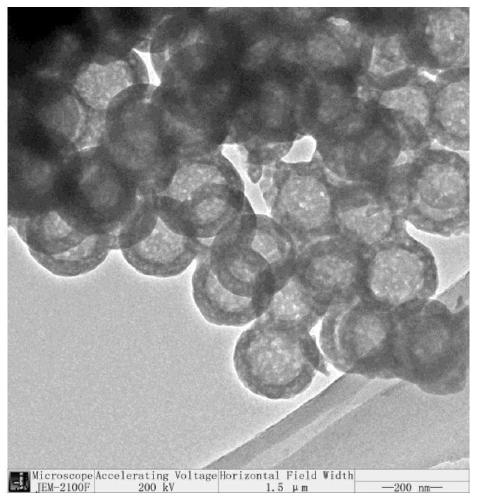Hollow mesoporous silica nanoparticles, nanocarriers and preparation methods thereof
A mesoporous silica and nano-carrier technology, applied in the direction of silica, silicon oxide, nanotechnology, etc., can solve the problems of limiting the prospect of in vivo application, weak transfection ability of antiserum, and decreased transfection efficiency, achieving Under the cytotoxicity of the vector, the effect of increasing the transfection efficiency and high gene transfection efficiency
- Summary
- Abstract
- Description
- Claims
- Application Information
AI Technical Summary
Problems solved by technology
Method used
Image
Examples
preparation example Construction
[0035] In one of the embodiments, the present invention provides a method for preparing hollow mesoporous silica nanoparticles, comprising the following steps:
[0036] (1) Alcohols, deionized water, and ammonia water are magnetically stirred and mixed at 20-50° C. (more preferably 25-35° C.);
[0037] (2) Continue mixing after adding tetraethyl orthosilicate rapidly to the product obtained in step 1;
[0038] (3) Continue mixing after adding premixed tetraethyl orthosilicate and octadecyltrimethoxysilane to the product obtained in step 2;
[0039] (4) After the obtained product is centrifuged, the lower layer of the precipitate is etched with sodium carbonate at 20-100° C. (more preferably 70-90° C.);
[0040] (5) Vacuum-dry the obtained product and calcinate at 300-600°C (more preferably 500-600°C) to obtain the hollow mesoporous silica nanoparticles; the mass ratio of ethanol, deionized water, and ammonia water For: 65-75:10:2-4. In step (2), the volume ratio of the cons...
Embodiment 1
[0043] Example 1: Preparation of Green Fluorescent Protein Hollow Mesoporous Silica Nanocarriers
[0044] The preparation method of the green fluorescent protein hollow mesoporous silica nanocarrier of the present embodiment comprises the following steps:
[0045] 1. Preparation of green fluorescent protein DNA (GFP-DNA)
[0046]Take 2.5g LB medium powder, add 100mL distilled water, and steam sterilize under 15psi high pressure for 20min. The 100 mL LB medium contains 1 g of peptone, 0.5 g of yeast, and 1 g of sodium chloride. Add kanamycin (to make the final concentration 50 μg / mL) and 1 mL of Escherichia coli transformed with green fluorescent protein gene (pEGFP) into 100 mL of sterilized LB medium in a biological safety cabinet. Incubate at 37.0°C with shaking at 200rpm for 14-16h. Add the bacterial solution cultured overnight into a centrifuge tube, centrifuge at room temperature at 4000 rpm for 6 minutes to collect the bacterial cells, discard the supernatant, and dry...
Embodiment 2
[0056] Example 2: Transfection efficiency of hollow mesoporous silica nanocarriers measured by flow cytometry
[0057] Count the human colon cancer cells (Lovo) after passage, dilute, add 2*10 per well of 24-well plate 5 After culturing for 24 hours, change the serum-free medium, and accurately weigh the hollow mesoporous silica nanoparticle prepared in Example 1 and the hollow mesoporous silica nanocarrier with a mass ratio of 1.8kDa PEI of 60:1 After 120 μg was mixed with 2 μg of GFP-DNA prepared in Example 1 for two hours, the obtained hollow mesoporous silica gene nanocarrier (HMSNs-1.8kDaPEI) was cultured with human colon cancer cells (Lovo) for 4 hours, and replaced with serum culture After 48 hours of culture, 200 μL of trypsin was added to digest the product. The resulting product was placed in a 1.5 mL EP tube, centrifuged at 1200 rpm for 3 minutes, washed once with phosphate buffered saline (PBS), and then 500 μL of PBS was added and measured by flow cytometry. The ...
PUM
| Property | Measurement | Unit |
|---|---|---|
| molecular weight | aaaaa | aaaaa |
| particle diameter | aaaaa | aaaaa |
| pore size | aaaaa | aaaaa |
Abstract
Description
Claims
Application Information
 Login to View More
Login to View More - Generate Ideas
- Intellectual Property
- Life Sciences
- Materials
- Tech Scout
- Unparalleled Data Quality
- Higher Quality Content
- 60% Fewer Hallucinations
Browse by: Latest US Patents, China's latest patents, Technical Efficacy Thesaurus, Application Domain, Technology Topic, Popular Technical Reports.
© 2025 PatSnap. All rights reserved.Legal|Privacy policy|Modern Slavery Act Transparency Statement|Sitemap|About US| Contact US: help@patsnap.com



